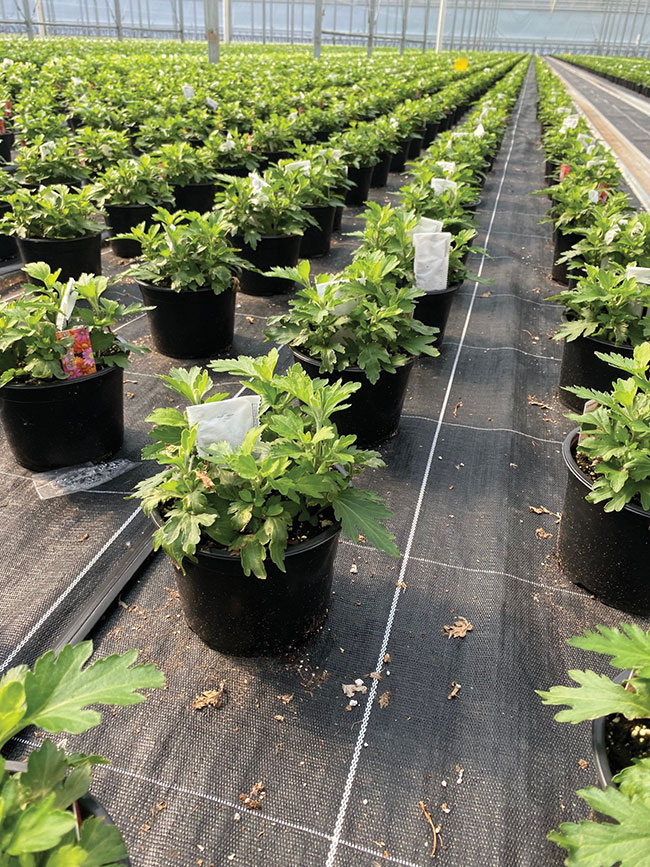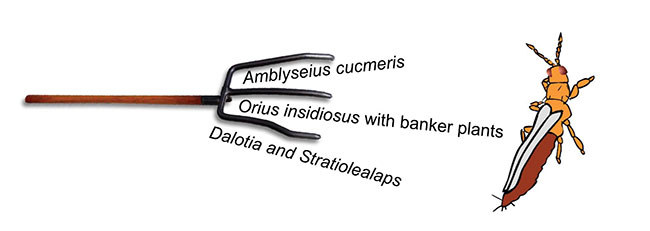
The pitchfork method
Often when growers and integrated pest management (IPM) managers are thinking and speaking of controlling pests with traditional pesticides, we think of product X being used for pest problem Z. This is also often the way people think about biological control. To be successful with biological control, however, the pitchfork approach is something to really embrace and execute.
Anyone who has used biological control successfully knows that this approach requires being proactive. Biological control is simply not suitable to control an already raging pest problem. Rather, it is an approach that avoids pest problems from happening in the first place. This has mainly to do with how biological control agents (BCAs) mode of action is, to keep it in pesticide terminology.
The biology, or the mode of action, of several BCAs is very specific to a small part of the life cycle of the pest problem that is being targeted. To use thrips and whiteflies as an example:
THRIPS
In the life cycle of thrips, the small and most commonly used BCA is a predatory mite called Amblyseius cucumeris, often released in breeding sachets (Figure 1). This small predatory mite is preying only on the first larval stage of thrips, which at 68° F is only 3 days, or 1.5 days at 86° F — only a very small window in the entire life cycle of thrips. This is the reason why starting early is so critical to keep thrips controlled. Besides feeding on the first larval stage of thrips, Amblyseius cucumeris also preys on broad mites.

There are other tools in the toolbox, however, that are affecting some of the other parts of the thrips life cycle.
The predatory mite Stratiolealaps scimitus (formerly known as Hypoaspis miles) and the rove beetle Dalotia coriaria are both generalist predators living in the top layer of the soil. This is the space where western flower thrips pupates, the stage after the two larval stages. Both these generalist soil predators have an appetite for the thrips pupae. After the pupal stage of thrips, adult thrips will appear if it has not been “caught” by the three predators already mentioned.
Orius insidiosus (minute pirate bug) is a larger predatory insect that can attack, kill and feed on adult thrips as well as thrips larvae. To mention specifically, Orius can kill up to 80 adult thrips per day, only feeding on a few. It is a true thrips killer, but also has an appetite for moth eggs and spider mites. By combining these four predators, three parts of the life stages of thrips are being controlled, making it almost impossible for thrips to become a problem. Each of these predators is a prong of the pitchfork (Figure 2).

WHITEFLIES
Many poinsettia growers are using biological control to prevent whiteflies from becoming a problem. Similar to thrips, there are BCAs that are focused on controlling parts of the life cycle of whiteflies.
To start, the predatory mite Amblyseius swirskii and the beetle Delphastus catalinae feed on whitefly eggs. Whitefly females produce approximately 200 eggs per female in their lifetime on poinsettia. Each Amblyseius swirskii feeds on 10 whitefly eggs per day, while the beetle Delphastus feeds on 160 whitefly eggs per day. This is why Delphastus is often used on hot spots due to its enormous appetite for whitefly eggs. Once whitefly eggs hatch, larval stages one (L1), two (L2) and three (L3) follow.
The wasps Encarsia formosa and Eretmocerus eremicus have two “modes of action.” Both wasps do host feeding by probing the younger larval stage with their ovipositioner, and then turn around and consume the fluids, killing the whitefly larvae in the process. Encarsia can host feed on three to four L1 per day whereas Eretmocerus eremicus can host feed on 20 to 30 L1 per day. The second “mode of action” is parasitism. Both wasps lay eggs in the older whitefly larval stage.
Encarsia formosa is not very suitable for Bemisa tabaci (sweet potato whitefly) which is most common in poinsettia crops but does an excellent job parasitizing greenhouse whitefly in other greenhouse crops. Eretmocerus eremicus can parasitize both sweet potato and greenhouse whitefly larvae, depositing an egg underneath the whitefly larva. Once this egg hatches, it enters the whitefly larva from underneath and uses the now whitefly pupae as a host to develop into a new wasp. As a result, a new wasp emerges from the pupa instead of a new whitefly.
By combining these four different BCAs, we are covering a large part of all the life stages of whiteflies, making it easier to keep the whitefly population at a low level. The only stages that are not being covered in this pitchfork approach are the pupae and adult stages.
Using several BCAs against one particular pest problem and their life stages makes biological control much more robust. Using the pitchfork approach, and BCAs focused on different parts of the life cycle of pests such as whitefly and thrips will keep these pest problems from becoming a problem. This is in essence the “mode of action” of biological control. Avoiding pests from becoming a problem in the first place rather than fixing an already established pest population.
For an enhanced reading experience, view this article in our digital edition by clicking here.


 Video Library
Video Library 




















